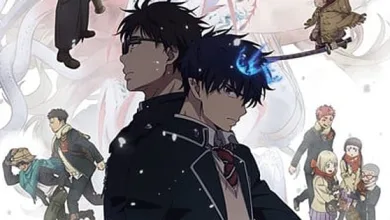Seven Deadly Sins: Four Knights of the Apocalypse Episodes 12-24 Anime Review – Review

Arthurian legend fans, prepare to find some fun references in this set of episodes. That’s always true of Nakaba Suzuki‘s works; the man is nothing if not consistent with his fondness for Arthurian lore, as the recent release of his earlier series’ anime adaptation, Rising Impact, amply demonstrates. But the Seven Deadly Sins franchise is where he really digs into it, and the second half of The Four Knights of the Apocalypse‘s first season enjoys dropping a few good bonus references. My favorite is the crystal cave where Percival and his cohort meet a tragic knight; I can’t prove that it directly references Mary Stewart‘s 1970 novel The Crystal Cave, the first in her Arthurian quintet. However, it feels likely, especially since Stewart relied on Welsh versions of Arthurian lore, which is also largely true of Suzuki in this series. We also get a monster named Cernunnos, for the Celtic horned god, but the most interesting depiction based on the lore is Guinevere.
It was only a matter of time until she was introduced, given that Lancelot is one of the main characters in this series. The revelation that the fox Sin was Lancelot all along isn’t particularly shocking (it was right there in his name – “the fox Sin,” as in Ban’s role in The Seven Deadly Sins), plus the two films about him and Tristan served as a prequel to this series. But Lancelot is one of the more difficult Arthurian characters, a French importation into the story who often replaces Gawain in later works. He is best known for his love affair with Arthur’s wife, Guinevere. Since Tristan already has Isolde and Percival has Anghalhad (Anne), it stands to reason that Guinevere would pop up. And so she does – briefly in episodes eighteen and nineteen. Even more than Lancelot, Guinevere is typically reduced to her role in their love affair, with some early sources even having her seduced by Mordred; in most of the earliest literature, she’s the “bad woman” whose sexuality causes the downfall of Camelot. The story doesn’t do a lot with her here, but the idea that she has prophetic dreams and has come to meet Lancelot in Liones suggests that Suzuki intends to reframe her literary tragedy into something more positive – because, after all, in this version of the legends, Arthur is evil.
Her brief appearance also shows a slight return to form for the series’ female characters. However, most of them remain intensely annoying compared to Elizabeth and Diane from the first series. Isolde’s obsession with Tristan, while at least a bit literarily accurate, fuels her snobbery, and she and the other members of Tristan’s squad continually go too far in their treatment of Percival and his friends. Anne is a bit better in these episodes than she was before, although in part, that’s because of the events of the crystal cave, where she comes to represent a lost daughter to a tragic knight; her worth is determined by how he sees her rather than through her actions, contrary to her first appearance in the series. And then there’s Gawain, the fourth Knight of the Apocalypse.
The main problem with Gawain is that she’s obnoxious. To a degree, that makes sense; she’s King Arthur’s niece (true to the source material, albeit with a gender swap) and very powerful all on her own, with powers similar to Escanor’s. She’s also a lesbian, which is a nice bit of representation, although her annoying factor dims that somewhat. But the biggest issue with her is that she’s a spoiled brat, going from bragging about her prowess to pitching a temper tantrum when things don’t go her way; it doesn’t feel like a coincidence that she’s the only knight without a squadron at the moment. This does feel like it relies less on the Welsh legends that the series largely uses, although the presence of Lancelot, who tends to eclipse Gawain in later tales, could explain that. But the persistent issue is that she’s just not enjoyable to watch, and as one of the main characters, that’s a real problem, especially since we don’t see as much of Donny, Nasiens, Anne, and Lancelot once the group reaches the city.
Still, even from more of a plot perspective, the group must get to Liones. Percival (who continues to be underestimated by those who don’t know him) gets to meet up with Meliodas, and it’s clear that he needs a father figure like him in his life. Although he’s been doing fine during his journey, the fact of the matter is that he’s still hurting from the loss of his grandfather and the reveal that his father is evil, and while Sin was able to fill a few gaps in, the two of them are the same age. Meliodas can reach Percival on a different level, one that he was obviously missing, and that does more for Percival’s development as both a character and a knight than almost anything else in the series so far. The events of the demon village in episodes twelve through fourteen help to solidify the parent/child relationships in the series, and that helps to guide Percival to meeting Meliodas, although arguably Anne got more emotional growth out of the interactions with Ardberg.
If the first half of this season was the “getting there” portion of the story, this second half is about finalizing the setup. All of the major players are assembled, including a few blasts from the past, and everything leads up to Arthur’s reappearance, which closes out the season. It doesn’t ever feel like it’s dragging, although a few events are much more meaningful in retrospect, and there are some genuinely interesting takes on Arthurian lore. Now, with everything in place, it seems like the second season will finally be able to truly take off. This hasn’t been amazing or terrible thus far, and I think it will change for the better in the future.
Source link
#Deadly #Sins #Knights #Apocalypse #Episodes #Anime #Review #Review



